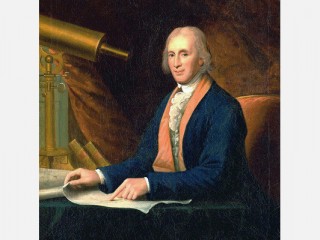
David Rittenhouse biography
Date of birth : 1732-04-08
Date of death : 1976-06-26
Birthplace : Germantown, Pennsylvania, U.S.
Nationality : American
Category : Arhitecture and Engineering
Last modified : 2011-02-12
Credited as : Astronomer, instrument maker, mathematician and surveyor
David Rittenhouse American astronomer and instrument maker, was a noted amateur scientist who constructed the finest orrery made at that time.
David Rittenhouse was born on April 8, 1732, near Germantown, Pa., into a poor farming family. He was stimulated by some books and tools of his uncle's and evidently educated himself in mathematics and astronomy. With help and encouragement from an Episcopal clergyman, he continued to advance his mathematical knowledge. In 1763 his boundary survey for Pennsylvania was so accurate that it was later accepted by the English surveyors Charles Mason and Jeremiah Dixon.
In 1767 Rittenhouse began his masterwork, the finest and most accurate orrery of that period. This mechanical representation of the movement of the planets through the universe was used widely in teaching and demonstration in the 18th century and also served as a demonstration of the reasonableness of nature. Rittenhouse's first orrery was capable of reproducing the relations of the planets forward or backward 5,000 years and emitted music when in operation.
Rittenhouse was in demand over the next few years by colleges that wanted him to make orreries, and the Commonwealth of Pennsylvania awarded him £300 as an honor and £300 more to make an orrery "for the use of the public." The fame derived from his orrery guaranteed him support for his observations in 1769 of the transit of Venus, which was an opportunity to measure the solar parallax. Rittenhouse's observations, made in a specially constructed laboratory, with instruments of his own design, were highly accurate and were favorably considered by European scientists working on the same problem.
In 1770 Rittenhouse moved to Philadelphia, where he was able to pursue a more active scientific career. He became a member of the informal scientific circle presided over by Thomas Jefferson. With his own improved telescopes he continued to make astronomical observations and to produce scientific and surveying instruments for himself and others, while making his living as a clockmaker. There is some uncertainty as to whether he independently developed a system of calculus, but he did become mathematically sophisticated and made some contributions in this area.
During the Revolutionary War, Rittenhouse was an avid patriot, serving on councils and committees of public safety, devising harbor defenses and methods of saltpeter production for gunpowder, and substituting iron weights in pendulum clocks to get lead for bullets. His last public service was as director of the U.S. Mint from 1792 to 1795. He died of cholera on June 26, 1796. He is often cited as an example of the untutored genius springing from American soil.
















